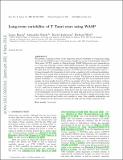Files in this item
Long-term variability of T Tauri stars using WASP
Item metadata
| dc.contributor.author | Rigon, Laura | |
| dc.contributor.author | Scholz, Alexander | |
| dc.contributor.author | Anderson, David | |
| dc.contributor.author | West, Richard | |
| dc.date.accessioned | 2017-04-24T15:30:12Z | |
| dc.date.available | 2017-04-24T15:30:12Z | |
| dc.date.issued | 2017-03-01 | |
| dc.identifier | 249721118 | |
| dc.identifier | 5522c590-88a8-4fb8-abaf-629598e47775 | |
| dc.identifier | 85014818501 | |
| dc.identifier | 000395170200010 | |
| dc.identifier.citation | Rigon , L , Scholz , A , Anderson , D & West , R 2017 , ' Long-term variability of T Tauri stars using WASP ' , Monthly Notices of the Royal Astronomical Society , vol. 465 , no. 4 , pp. 3889-3901 . https://doi.org/10.1093/mnras/stw2977 | en |
| dc.identifier.issn | 0035-8711 | |
| dc.identifier.other | BibCode: 2017MNRAS.465.3889R | |
| dc.identifier.uri | https://hdl.handle.net/10023/10650 | |
| dc.description.abstract | We present a reference study of the long-term optical variability of young stars using data from the WASP project. Our primary sample is a group of well-studied classical T Tauri stars (CTTSs), mostly in Taurus-Auriga. WASP light curves cover time-scales of up to 7 yr and typically contain 10 000-30 000 data points. We quantify the variability as a function of time-scale using the time-dependent standard deviation'pooled sigma'. We find that the overwhelming majority of CTTSs have a low-level variability with σ <0.3 mag dominated by time-scales of a few weeks, consistent with rotational modulation. Thus, for most young stars, monitoring over a month is sufficient to constrain the total amount of variability over time-scales of up to a decade. The fraction of stars with a strong optical variability (σ > 0.3 mag) is 21 per cent in our sample and 21 per cent in an unbiased control sample. An even smaller fraction (13 per cent in our sample, 6 per cent in the control) show evidence for an increase in variability amplitude as a function of time-scale from weeks to months or years. The presence of long-term variability correlates with the spectral slope at 3-5μm, which is an indicator of inner disc geometry, and with the U-B band slope, which is an accretion diagnostics. This shows that the long-term variations in CTTSs are predominantly driven by processes in the inner disc and in the accretion zone. Four of the stars with long-term variations show periods of 20-60 d, significantly longer than the rotation periods and stable over months to years. One possible explanation is cyclic changes in the interaction between the disc andthe stellar magnetic field. | |
| dc.format.extent | 2121298 | |
| dc.language.iso | eng | |
| dc.relation.ispartof | Monthly Notices of the Royal Astronomical Society | en |
| dc.subject | Protoplanetary discs | en |
| dc.subject | Circumstellar matter | en |
| dc.subject | Stars: formation | en |
| dc.subject | Stars: low-mass | en |
| dc.subject | Stars: variables: T Tauri | en |
| dc.subject | Herbig Ae/Be | en |
| dc.subject | QB Astronomy | en |
| dc.subject | QC Physics | en |
| dc.subject | NDAS | en |
| dc.subject.lcc | QB | en |
| dc.subject.lcc | QC | en |
| dc.title | Long-term variability of T Tauri stars using WASP | en |
| dc.type | Journal article | en |
| dc.contributor.sponsor | Science & Technology Facilities Council | en |
| dc.contributor.sponsor | European Commission | en |
| dc.contributor.institution | University of St Andrews. School of Physics and Astronomy | en |
| dc.contributor.institution | University of St Andrews. St Andrews Centre for Exoplanet Science | en |
| dc.identifier.doi | https://doi.org/10.1093/mnras/stw2977 | |
| dc.description.status | Peer reviewed | en |
| dc.identifier.url | https://arxiv.org/abs/1611.03013 | en |
| dc.identifier.url | http://adsabs.harvard.edu/abs/2017MNRAS.465.3889R | en |
| dc.identifier.grantnumber | ST/M001296/1 | en |
| dc.identifier.grantnumber | 284405 | en |
This item appears in the following Collection(s)
Items in the St Andrews Research Repository are protected by copyright, with all rights reserved, unless otherwise indicated.

